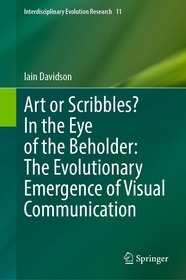
Art or Scribbles? In the Eye of the Beholder: The Evolutionary Emergence of Visual Communication
Sorozatcím: Interdisciplinary Evolution Research; 11;
-
12% KEDVEZMÉNY?
- A kedvezmény csak az 'Értesítés a kedvenc témákról' hírlevelünk címzettjeinek rendeléseire érvényes.
- Kiadói listaár EUR 171.19
-
71 001 Ft (67 620 Ft + 5% áfa)
Az ár azért becsült, mert a rendelés pillanatában nem lehet pontosan tudni, hogy a beérkezéskor milyen lesz a forint árfolyama az adott termék eredeti devizájához képest. Ha a forint romlana, kissé többet, ha javulna, kissé kevesebbet kell majd fizetnie.
- Kedvezmény(ek) 12% (cc. 8 520 Ft off)
- Kedvezményes ár 62 481 Ft (59 506 Ft + 5% áfa)
Iratkozzon fel most és részesüljön kedvezőbb árainkból!
Feliratkozom
71 001 Ft

Beszerezhetőség
Megrendelésre a kiadó utánnyomja a könyvet. Rendelhető, de a szokásosnál kicsit lassabban érkezik meg.
Why don't you give exact delivery time?
A beszerzés időigényét az eddigi tapasztalatokra alapozva adjuk meg. Azért becsült, mert a terméket külföldről hozzuk be, így a kiadó kiszolgálásának pillanatnyi gyorsaságától is függ. A megadottnál gyorsabb és lassabb szállítás is elképzelhető, de mindent megteszünk, hogy Ön a lehető leghamarabb jusson hozzá a termékhez.
A termék adatai:
- Kiadó Springer Nature Switzerland
- Megjelenés dátuma 2025. augusztus 8.
- Kötetek száma 1 pieces, Book
- ISBN 9783031904578
- Kötéstípus Keménykötés
- Terjedelem446 oldal
- Méret 235x155 mm
- Nyelv angol
- Illusztrációk XXXV, 446 p. 224 illus., 196 illus. in color. Illustrations, black & white 685
Kategóriák
Hosszú leírás:
"
The book is about how art arose; and how it became what we call art today. How did art emerge from the relationships between people and the things they produce and the ideas of producers? How do people manipulate those relationships in their own society? How do outsiders work out the ways in which those relationships were used to make art?
What is art and why are all people engaged with it in one way or another? From its very beginning, and everywhere, art has always been embedded in its cultural context—the contexts of the people who made and see it—and that context has often been ritual. The history of art confused “social and institutional changes” of view because western critics (or artists) sought to define the boundaries of art so tightly that ritual, purposeful or utilitarian works were excluded from it. In their definition, art only existed if the rituals of the original producers were stripped from the works or if the objects were appropriated away from the situation in which they were produced. The objects stripped from their context could then only be valued for their aesthetics. Art consists of relationships between people, things, and ideas in quite specific ways. Those relationships are discussed at length in this book.
The book is aimed at artists, art historians and archaeologists, but also at the general public interested in art. It is intended both for people whose interest in art comes from knowledge of the art of all continents, and for those who have no knowledge.
" TöbbTartalomjegyzék:
Chapter 1: Art or Scribbles.- Chapter 2: Art is too important to be left to those who are interested in art.- Chapter 3: Art, rock art or not art.- Chapter 4: Art and communication.- Chapter 5: Graphic elements in communication.- Chapter 6: Meaning, expectations, agents and scenes.- Chapter 7: Painting by numbers. Seven Types of Ambiguity in Art.- Chapter 8: But is it Art—let me count the ways.- Chapter 9: Art and archeohistory of Sahul (the continent of greater Australia and New Guinea).- Chapter 10: a thousand words.
Több



